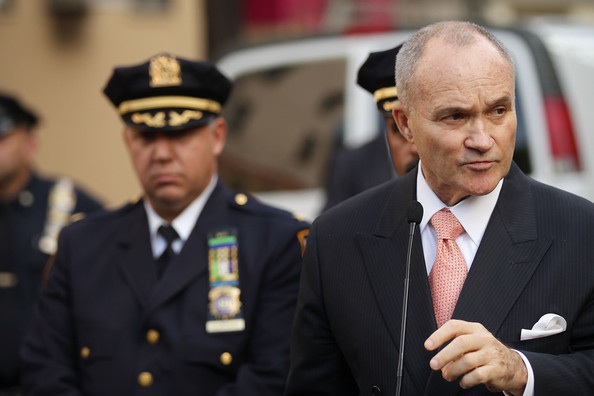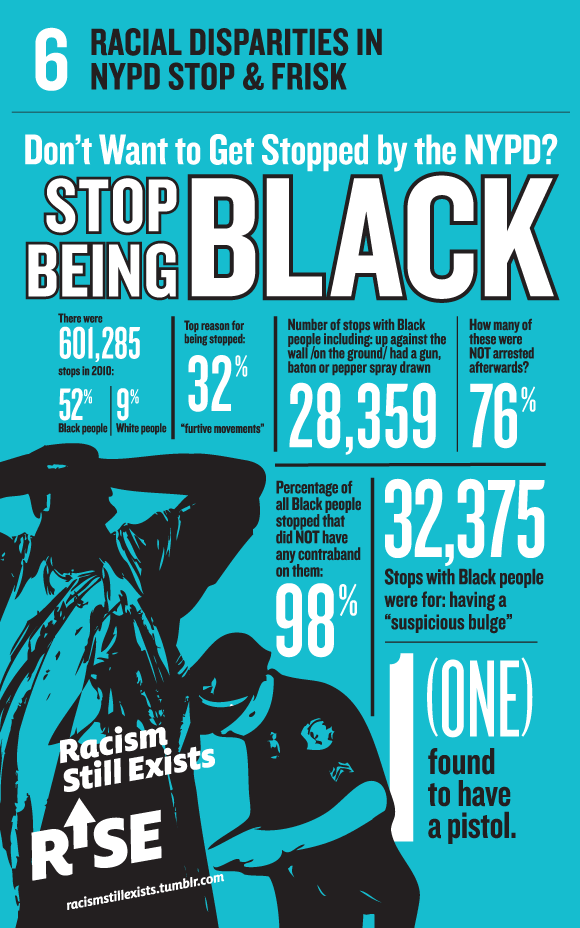Judge says NYPD's Systematic Stop & Frisk of Non-Whites Violates Constitution
 A federal judge has found that the NYPD ordered its overseers (officers) to violate the Constitutional rights of non-whites as a matter of policy. This of course is of no moment to many white people or their media, who are supportive or indifferent to such practices of white supremacy (like ID "Papers Please" laws). Similar to the increasingly meaningless 4th Amendment rights of non-whites, during Nazi Germany, various residency/movement regulations and identification measures were undertaken against Jews by the Government as preconditions to genocide. [MORE] In her written opinion the judge proposed that cops wear body cameras to record their encounters with non-white people and host more community meetings. But, the only remedy that will actually produce justice is to end white supremacy/racism.
A federal judge has found that the NYPD ordered its overseers (officers) to violate the Constitutional rights of non-whites as a matter of policy. This of course is of no moment to many white people or their media, who are supportive or indifferent to such practices of white supremacy (like ID "Papers Please" laws). Similar to the increasingly meaningless 4th Amendment rights of non-whites, during Nazi Germany, various residency/movement regulations and identification measures were undertaken against Jews by the Government as preconditions to genocide. [MORE] In her written opinion the judge proposed that cops wear body cameras to record their encounters with non-white people and host more community meetings. But, the only remedy that will actually produce justice is to end white supremacy/racism.
 From [HERE] In a repudiation of a major element in the Bloomberg (racist suspect in photo) administration’s crime-fighting legacy, the judge, Shira A. Scheindlin has found that the stop-and-frisk tactics of the New York Police Department violated the constitutional rights of non-whites in New York, and called for a federal monitor to oversee broad reforms.
From [HERE] In a repudiation of a major element in the Bloomberg (racist suspect in photo) administration’s crime-fighting legacy, the judge, Shira A. Scheindlin has found that the stop-and-frisk tactics of the New York Police Department violated the constitutional rights of non-whites in New York, and called for a federal monitor to oversee broad reforms.
In a decision issued on Monday, the Court ruled that police officers have for years been systematically stopping innocent people in the street without any objective reason to suspect them of wrongdoing. Officers often frisked these people, usually young minority men, for weapons or searched their pockets for contraband, like drugs, before letting them go, according to the 195-page decision.
Over the past decade the city has conducted about 5 million stop and frisks. The vast majority of residents who have been stopped, more than 80 percent, have been black or Latino. [MORE]
Above, White NYPD Deputy Inspector Recorded Telling Officer to Target Young Black Men Wearing Dark Clothing [MORE]
These stop-and-frisk episodes, which soared in number over the last decade as crime continued to decline, demonstrated a widespread disregard for the Fourth Amendment, which protects against unreasonable searches and seizures by the government, according to the ruling. It also found violations with the 14th Amendment’s equal protection clause.
Judge Scheindlin found that the city “adopted a policy of indirect racial profiling by targeting racially defined groups for stops based on local crime suspect data.” She rejected the city’s arguments that more stops happened in minority neighborhoods solely because those happened to have high-crime rates.
“I also conclude that the city’s highest officials have turned a blind eye to the evidence that officers are conducting stops in a racially discriminatory manner,” she wrote.
Noting that the Supreme Court had long ago ruled that stop-and-frisks were constitutionally permissible under certain conditions, the judge stressed that she was “not ordering an end to the practice of stop-and-frisk. The purpose of the remedies addressed in this opinion is to ensure that the practice is carried out in a manner that protects the rights and liberties of all New Yorkers, while still providing much needed police protection.”
To fix the constitutional violations, the judge designated an outside lawyer, Peter L. Zimroth, to monitor the Police Department’s compliance with the Constitution.
Judge Scheindlin also ordered a number of other remedies, including a pilot program in which officers in at least five precincts across the city will wear body-worn cameras in an effort to record street encounters. She also ordered a “joint remedial process” — in essence, a series of community meetings — to solicit public input on how to reform stop-and-frisk.
The decision to install Mr. Zimroth, a partner in the New York office of Arnold & Porter LLP, and a former corporation counsel and prosecutor in the Manhattan district attorney’s office, will leave the department under a degree of judicial control that is certain to shape the policing strategies under the next mayor.
Relying on a complex statistical analysis presented at trial, Judge Scheindlin found that the racial composition of a census tract played a role in predicting how many stops would occur.
She emphasized what she called the “human toll of unconstitutional stops,” noting that some of the plaintiffs testified that their encounters with the police left them feeling that they did not belong in certain areas of the cities. She characterized each stop as “a demeaning and humiliating experience.”
“No one should live in fear of being stopped whenever he leaves his home to go about the activities of daily life,” the judge wrote. During police stops, she found, blacks and Hispanics “were more likely to be subjected to the use of force than whites, despite the fact that whites are more likely to be found with weapons or contraband.”
The ruling, in Floyd v. City of New York, follows a two-month nonjury trial in Federal District Court in Manhattan earlier this year over the department’s stop-and-frisk practices.
Judge Scheindlin heard testimony from about a dozen black or biracial men and a woman who described being stopped, and she heard from statistical experts who offered their conclusions based on police paperwork describing some 4.43 million stops between 2004 and mid-2012. Numerous police officers and commanders testified as well, typically defending the legality of stops and saying they were made only when officers reasonably suspected criminality was afoot.
While the Supreme Court has long recognized the right of police officers to briefly stop and investigate people who are behaving suspiciously, Judge Scheindlin found that the New York police had overstepped that authority. She found that officers were too quick to deem as suspicious behavior that was perfectly innocent, in effect watering down the legal standard required for a stop.
“Blacks are likely targeted for stops based on a lesser degree of objectively founded suspicion than whites,” she wrote.
She noted that about 88 percent of the stops result in the police letting the person go without an arrest or ticket, a percentage so high, she said, that it suggests there was not a credible suspicion to suspect the person of criminality in the first place.

